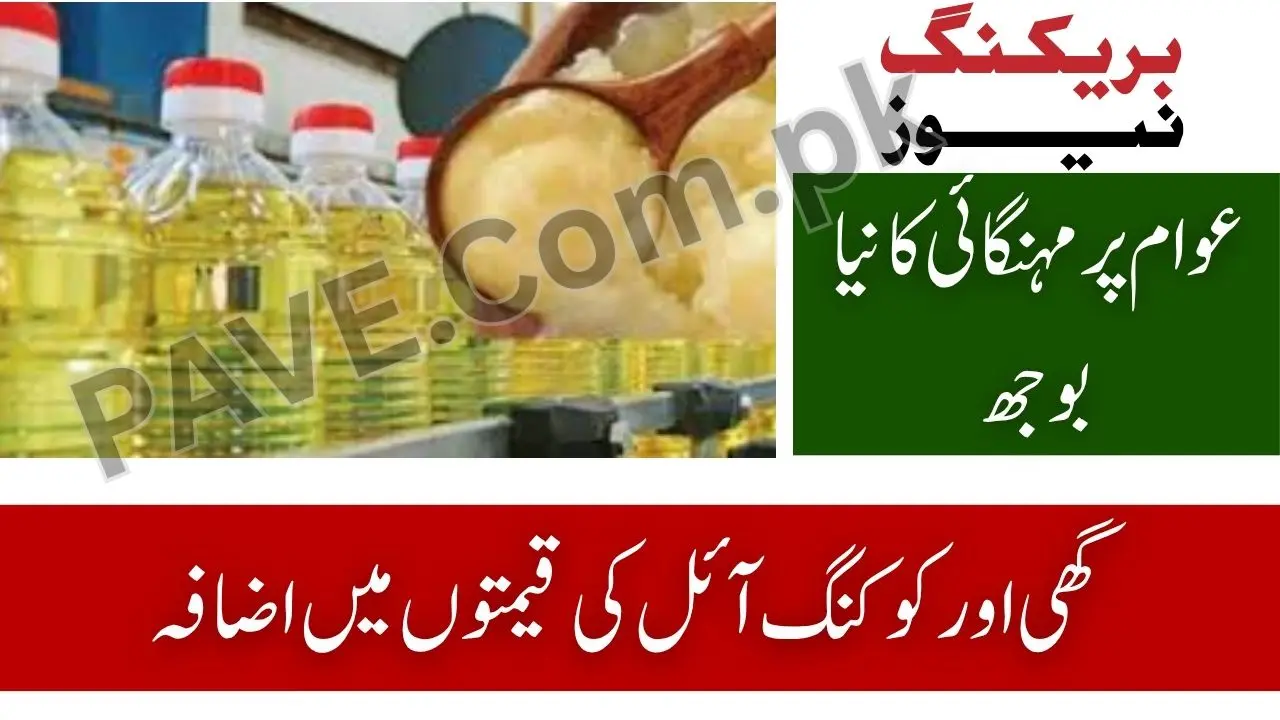Ghee and Cooking Oil Prices Increase in Pakistan 2025 — Check New Rates & Expert Analysis
The prices of Ghee and Cooking Oil Prices Increase in Pakistan, worsening the inflationary pressure already weighing down millions of households. As per the latest market survey, premium-grade ghee and oil have risen by Rs. 10, taking their price to Rs. 582 per kilogram or litre, while second-tier variants now sell for around Rs. 540 per kilogram.
Consumers say this price jump has made it nearly impossible to maintain household budgets. With food, transport, and utility expenses already climbing, the rise in essential cooking items has added yet another layer of stress for ordinary citizens.
🔹 Market Overview — What’s Happening?
According to wholesale traders and retail associations, the hike is linked to both international commodity price trends and domestic logistical challenges. Global palm and soybean oil prices have increased due to production disruptions in Southeast Asia, while higher diesel costs in Pakistan have amplified transport expenses.
Moreover, the rupee’s recent depreciation against the dollar has made imported raw materials significantly more expensive. Since Pakistan depends heavily on imported edible oils, even small currency shifts have a big impact on local retail prices.
📊 Updated Price Comparison (October 2025)
| Product | Old Price (PKR/kg or litre) | New Price (PKR/kg or litre) | Change | Trend |
|---|---|---|---|---|
| Premium Ghee / Oil | 572 | 582 | +10 | 🔺 Increasing |
| Mid-Range Brands | 530 | 540 | +10 | 🔺 Increasing |
| Sugar | 177 | 179 | +2 | 🔺 Slight Increase |
| Tomato (per kg) | 368 | 500 – 700 | +132 – 332 | 🔺 Sharp Rise |
Retailers note that these prices vary slightly across cities, with Karachi and Lahore reporting the steepest jumps due to higher logistics and demand.
Check Also: Breaking News: Sindh to Change Intermediate Syllabus and Launch Daily Library Classes 2025
🛒 Impact on Pakistani Households
Families across Punjab, Sindh, and Khyber Pakhtunkhwa are feeling the pinch. Housewives say monthly grocery budgets that once lasted 25 days now run short before the 20th.
“Everything from flour to sugar has gone up. Now ghee and oil are touching new highs. Even a simple home-cooked meal is becoming unaffordable,” says Samina Bibi, a resident of Lahore’s Johar Town.
Small eateries, tandoors, and street-food vendors are also passing increased costs on to customers, triggering a ripple effect across food prices.
🌍 Global and Domestic Reasons Behind the Price Spike
Experts identify several key drivers:
- International Market Volatility — Edible-oil producing nations such as Malaysia and Indonesia are facing climate-related supply shortages.
- Currency Devaluation — The Pakistani rupee’s depreciation has inflated import bills, particularly for palm and soybean oil.
- Rising Fuel Prices — Diesel and petrol hikes increase transport and manufacturing costs.
- Middleman Margins — Lack of direct supply chains allows multiple layers of distributors to profit, raising retail rates.
- Weak Local Production — Pakistan imports over 70 % of its edible oil needs, leaving consumers exposed to global fluctuations.
🚚 Regional Price Differences
While Karachi’s Burns Road and Gulshan-e-Iqbal are seeing the highest rates — up to Rs. 590/kg — smaller cities such as Multan, Sialkot, and Faisalabad still offer relatively lower prices (Rs. 555–560/kg).
In northern areas and Balochistan, limited transport routes have caused even sharper increases, as delivery delays reduce local supply.
📈 Inflationary Pressure & Expert Forecast
Pakistan’s food inflation already exceeds 31 %, and analysts fear this could touch 35 % by early 2026 if current trends persist. The Pakistan Vanaspati Manufacturers Association (PVMA) has warned that if global prices rise another 5 %, domestic rates might jump by an additional Rs. 10–15 per kg next month.
“We are facing double pressure — high import bills and costly domestic transportation. Unless duties are cut, prices will keep climbing,” said a PVMA official.
Check Also: Breaking News: Virat Kohli Duck Record Shocks Fans in 2025
🏛️ Government Measures and Utility Stores Relief
To soften the blow, the Ministry of Industries and Production is considering a temporary subsidy for basic edible commodities through the Utility Stores Corporation. The Benazir Income Support Program (BISP) may also include a cooking-oil subsidy in its next tranche for low-income families.
Provincial governments are stepping in too. Punjab’s Price Control Committee has instructed district authorities to monitor profiteering and ensure price displays in all shops.
🌾 Calls for Local Production Boost
Agriculture experts argue that the long-term solution lies in expanding oilseed cultivation within Pakistan.
Pakistan currently cultivates less than 400,000 hectares of sunflower, canola, and soybean — far below potential. Increasing domestic oilseed production could:
- Reduce import dependency by 40 %.
- Save $1.5 billion annually in foreign exchange.
- Stabilize local edible-oil prices in the long run.
The Ministry of Food Security is already evaluating a National Oilseed Revival Plan 2026, which could incentivize farmers with seed subsidies and guaranteed procurement prices.
💬 Public Reactions
Social media is flooded with complaints:
- “Ghee was Rs. 400 two years ago, now it’s nearly Rs. 600 — no one can afford it.”
- “Tomatoes are more expensive than apples; soon cooking will be a luxury.”
- “Government must control middlemen and stop profiteering.”
Consumer groups have urged the Competition Commission of Pakistan (CCP) to investigate alleged cartelization among major edible-oil manufacturers.
📉 Comparison with Neighbouring Countries
| Country | Avg. Price (per kg) | Currency | Trend | Notes |
|---|---|---|---|---|
| Pakistan | Rs. 582 | PKR | 🔺 Rising | Import-dependent |
| India | Rs. 480 | PKR eq. | 🔻 Slight drop | Local production support |
| Bangladesh | Rs. 515 | PKR eq. | ➖ Stable | Govt price caps |
| Malaysia | Rs. 460 | PKR eq. | 🔻 Falling | Export country |
Pakistan remains the most expensive market in the region for edible oils, largely because it imports raw materials and pays duties on refined oil imports.
⚠️ Expert Recommendations
Economic think-tanks suggest several immediate and strategic actions:
- Cut import duties on palm and soybean oil.
- Reinforce supply chains to reduce transport costs.
- Cap retailer margins during inflationary spikes.
- Promote local oilseed farming with modern equipment and subsidies.
- Enhance public awareness through price-comparison portals.
🧮 Inflation Outlook for 2025-26
If global oil prices stabilize and the rupee remains around Rs. 280 per USD, edible-oil prices may plateau by mid-2026. However, any further devaluation or fuel price surge could reignite another inflation wave before Ramadan 2026.
🧠 Consumer Advice
Consumers can manage costs by:
- Purchasing ghee and oil in bulk directly from wholesalers.
- Tracking government-notified prices via local administration websites.
- Opting for Utility Stores or BISP relief shops for subsidized goods.
- Exploring local brands using domestically refined oil to avoid import mark-ups.
Check Also: Breaking News: Govt Announces Cheaper Electricity for Industrial and Agricultural Sectors for Next 3 Years
❓ Frequently Asked Questions (FAQs) about Ghee and Cooking Oil Prices Increase in Pakistan 2025:
Q1. What is the current price of ghee and cooking oil in Pakistan?
As of October 2025, premium brands are priced around Rs. 582/kg, while mid-range variants sell for Rs. 540/kg.
Q2. Why are prices rising again?
Because of international commodity hikes, rupee depreciation, and higher domestic transport costs.
Q3. Will the prices decrease soon?
Experts say stability may come in 2026 if import duties are eased and global prices settle.
Q4. Which city has the highest rates?
Karachi currently leads with prices exceeding Rs. 590/kg in certain markets.
Q5. Is the government offering any relief?
Yes, the Utility Stores Corporation and BISP are considering subsidies for low-income consumers.







